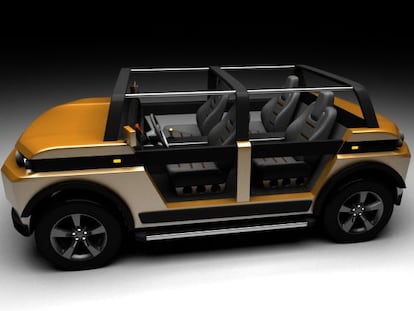Using ideas from the past for the future
The projects at the Iberoamerican Design Biennial aim to strip away the superfluous


The Itaipu Dam, located on the Paraná River near the border between Paraguay and Brazil, is the biggest hydroelectric facility in the world, and generates clean energy. César, Javier and David Vega, all from Paraguay, thought that a vehicle might be able to take advantage of that power. The Aguara off-road vehicle, which can travel 190 kilometers after an eight-hour charge, has won the best industrial design prize at the third Iberoamerican Design Biennial (BID 12). The car, along with a number of other projects from the competition, are currently on show at the Matadero cultural center in Madrid.
The name of the car, which means fox in the Paraguayan guaraní language, refers to the long legs of the native animal in the region. But it is also a nod to the cunning, shrewdness and ingenuity that the objects of the future will need in order to compete in world markets that are already saturated with products.
Manuel Estrada, the executive president of the biennial, says that "the market is no longer valid as the only defender of success." One of the keys to the biennial is the connection between different disciplines when it comes to design. Fashion and graphics, and furnishings and technology are under scrutiny here but they are all seen as connected. "All designs feed off disciplines," argues Steven Heller, the former art editor at The New York Times and a member of the jury that evaluated the 404 objects that were chosen for this edition. "Design is a cohesive activity."
For evidence that designers examine day-to-day life for inspiration, look no further than the work of Jorge Prieto Domínguez from Chile, who came up with a system for the transportation, cleaning and chilling of recently picked fruit, which makes use of a well. An open channel of running water that carries the fruit to a container helps the workers increase their efficiency. But the system also makes their job easier, looks after the fruit and avoids the unnecessary transportation of crates.
We see projects with big ideas from people without any resources"
Diseño para todos (or, Design for all) is the title of the prize that the ONCE Foundation gives out as part of the biennial, based on an assessment of universal accessibility, a task to which Erika Foureaux, from Brazil, has responded to with the design of an ultra-light chair. It's portable and folds up, and supports children with disabilities without the need to use restraints.
Many of these projects encourage designs that are focused on the truly essential, and are based on real necessities. These are not minimalist designs, but rather ones that take a wider view, looking at craftsmanship and industry with equal importance, as well as taking into account ideas from the past as a way of approaching the future.

The esthetic component is often the fundamental element in these designs. José Fernando Vázquez, from Puerto Rico, came up with Spiritree, a funeral urn that transforms into a living memorial. It's a container with a biodegradable base, made of organic compost. The top is porous ceramic, and has a hole in the middle. The ashes of the deceased, which are rich in calcium and phosphates, mix with the biodegradable material to provide sustenance for a plant. As it grows, it breaks through the protective ceramic, turning a funeral rite into a process filled with hope.
Gloria Escribano, the coordinator of the biennial, says that the most positive aspect of the event is what it teaches people. "We see projects with big ideas from people without any resources, training or experience," she explains. "At the biennial we also show people how the world of design works." They are not selling magic formulas, but rather they set out to help with the easy part - writing a clear plan of action - once the difficult part has been done: coming up with an idea in the first place.
Tu suscripción se está usando en otro dispositivo
¿Quieres añadir otro usuario a tu suscripción?
Si continúas leyendo en este dispositivo, no se podrá leer en el otro.
FlechaTu suscripción se está usando en otro dispositivo y solo puedes acceder a EL PAÍS desde un dispositivo a la vez.
Si quieres compartir tu cuenta, cambia tu suscripción a la modalidad Premium, así podrás añadir otro usuario. Cada uno accederá con su propia cuenta de email, lo que os permitirá personalizar vuestra experiencia en EL PAÍS.
¿Tienes una suscripción de empresa? Accede aquí para contratar más cuentas.
En el caso de no saber quién está usando tu cuenta, te recomendamos cambiar tu contraseña aquí.
Si decides continuar compartiendo tu cuenta, este mensaje se mostrará en tu dispositivo y en el de la otra persona que está usando tu cuenta de forma indefinida, afectando a tu experiencia de lectura. Puedes consultar aquí los términos y condiciones de la suscripción digital.








































